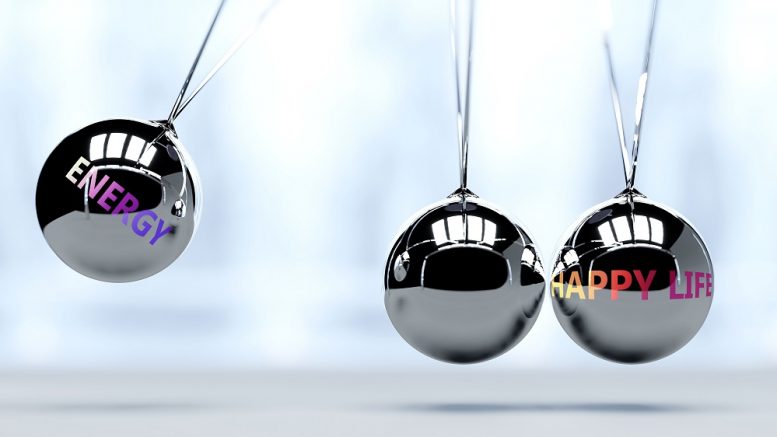Energy Measurement
We all feel each other’s energy, whether we’re aware of it or not. Each time our heart beats, a magnetic field travels out of our bodies and extends in all directions. This field can be measured with magnetometers. Gerhard Baule and Richard McFee first demonstrated the first biomagnetic signal in 1863 with a magnetocardiogram (MCG) that used magnetic induction coils to detect fields generated by the human heart. Research indicates that we feel each other’s energy as far as three feet away from the body.[1] Many scientists believe we can feel each other’s energy further, but distance measurement is limited by current technology. In comparison, the energy from our brain expands to only about an inch away from the head. We can think of this magnetic field as our personal environment. Studies demonstrate that different thoughts, attitudes, and emotions create different signals that are broadcast by the heart’s magnetic field.
Energy Awareness
Have you ever had the experience of asking someone how they are and having them smile and respond indicating that everything is fine, but you intuitively knew that something seemed a bit off? Our attitudes and our emotions affect other people, not only through body language and tone of voice but also through these magnetic fields. When we are stressed, anxious, afraid, happy, excited, or hopeful, whatever emotions we are experiencing, that energy can affect ourselves and others whether we are conscious of it or not. We “broadcast” information about how we’re feeling.
Energy Management
Energy management can be learned. Not only can we be resilient, we can also increase our capacity for resilience. In a resilient state, also known as being in coherence, we have access to our prefrontal cortex (our thinking brain) so that we can respond to situations, communicate and problem-solve more effectively.
One of the best things that we can do to support each other, and our teams is to maintain our own coherence. This makes it easier for the person having a tough time to regain balance and composure. For example, when I offer HeartMath workshops sometimes I have someone using the biofeedback technology struggling to get coherent. They might say, “I don’t understand. I meditate, do yoga and I sleep well.” It is because there is a difference between being relaxed and being in a state of coherence. Each time this has happened, if I simply sit next to them and become coherent myself, they also shift into coherence. Imagine a first responder arriving at a call; we would want them to be in a state of coherence, not relaxation.
When we are aware of the energy we are emitting, we can step into a room and make a conscious decision about what energy we want to bring – what do we want others around us to feel? Do we want them to feel inspired, respected or safe? Do we want them to feel encouraged or valued?
Energy and Communication
If we come to a conversation with feelings of frustration, anxiety or judgment, those unspoken depleting emotions are often misinterpreted and internalized. This creates drama and incoherence and leads to ineffective communication. Likewise, when we transfer unspoken feelings such as appreciation, calm, hope or even curiosity our renewing emotions positively impact our communication and lead to co-creation and collaboration. Ineffective communication can drain our energy. Examples of energy drains in communication include drama, blame, rehashing, resignation, and justification.
According to a study ineffective company communication creates workplace anxiety for 80% of US employees. (Softactivity, 2021). According to research conducted by US firm Garter, poor communication is responsible for 70% of corporate errors. Effective communication results in less stress and increased productivity and quality.
Improving Communication
When our message and our emotions don’t match, our ability to transmit and receive information effectively will be compromised. For effective communication, a simple practice is to be present and actively listen to what is being said without thoughts of your own agenda of how you will respond. Simply listen without judgment first. Confirm understanding by responding with “this is what I heard you say, is that correct?” You can also say, “Can you explain that in more detail? I want to make sure I understand what you’re saying.”
It helps to ask ourselves, “How am I showing up? What energy am I sending?” As a certified HeartMath trainer and Flow Energy Balance Indicator (FEBI) assessment provider I have the honor of helping leaders and teams build their capacity for resilience and also work with their energy patterns. The many benefits to being resilient include less intensity to emotional triggers and enhancements such as better decision making, reduced errors, less fatigue, better communication and reduced stress.
Let’s connect for a complimentary consultation and assessment. Please schedule a time via our website: www.goldencareerstategies.com or call Stacey at 864-527-0425.
About the Author
 Stacey Bevill is the owner and president of Golden Career Strategies. She has over 20 years of business and marketing experience and has master’s level certifications in coaching, marketing strategies, entrepreneurship, and project management. Bevill is passionate about helping organizations improve communication, employee engagement and motivation, and mental fitness. She also strongly supports individuals in transition and those interested in personal leadership and vision, resiliency, and wellness.
Stacey Bevill is the owner and president of Golden Career Strategies. She has over 20 years of business and marketing experience and has master’s level certifications in coaching, marketing strategies, entrepreneurship, and project management. Bevill is passionate about helping organizations improve communication, employee engagement and motivation, and mental fitness. She also strongly supports individuals in transition and those interested in personal leadership and vision, resiliency, and wellness.
Stacey is a credentialed Professional Certified Coach (PCC) by the International Coach Federation (ICF), a Board Certified Coach from the Center for Credentialing and Education (CCE), and is certified by the internationally acclaimed Newfield Network Coaching Institute. Additional training includes Positive Intelligence, Conversational Intelligence Enhanced Practitioner, Inspired Leadership from Case Western Reserve University, and Coaching for Managers. Stacey is a HeartMath® Certified Coach, Trainer, and Stress & Well-Being Assessment Provider. She is a Flow Energy Balance Indicator (FEBI® ) Assessment Certified Coach (Leadership Patterns) and a Strong Interest Inventory® and MBTI® Certified Practitioner. She is also a credentialed Harrison Assessments provider for both individuals and organizations.
She has received “value-added” training for her manufacturing clients: Certified Local Change Agent (credentialed by APMG), Certified Master Project Manager,® Lean Six Sigma Black Belt training certification, ISO 9001:2015 Standard & Internal/Supplier Auditor, IATF 16949: 2016 – Understanding Standard and Auditing, Stacey is a graduate of Leadership South Carolina, Leadership Spartanburg, The Women’s Campaign School at Yale, The Spartanburg County Foundation’s Grass Roots Leadership Development Institute, and Furman Connections: Women Leaders of the Upstate. She is an active volunteer with One to One: Women Coaching Women as a coach lead and volunteer coach and serves as one of four volunteer coaches in South Carolina for Stand Beside Them. She also provides coaching worldwide for Non-Profit Executive Directors through CoachAid. Stacey received the Rotary International District Service Above Self award in 2007.
[1] HeartMath, Energetic Communication https://www.heartmath.org/research/science-of-the-heart/energetic-communication/#:~:text=Furthermore%2C%20the%20magnetic%20field%20produced,based%20magnetometers%20(Figure%206.1).




Be the first to comment on "Energy in Leadership"